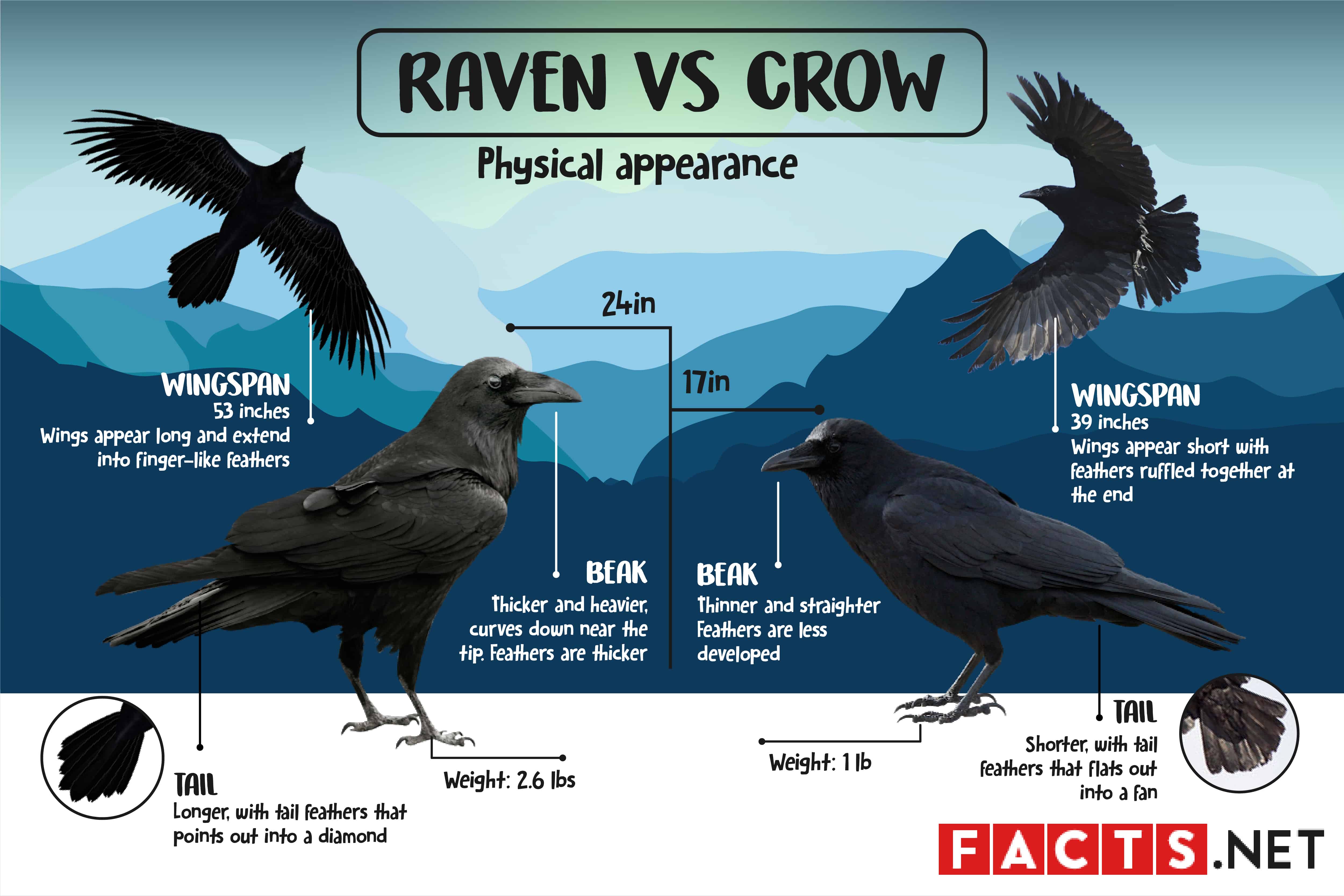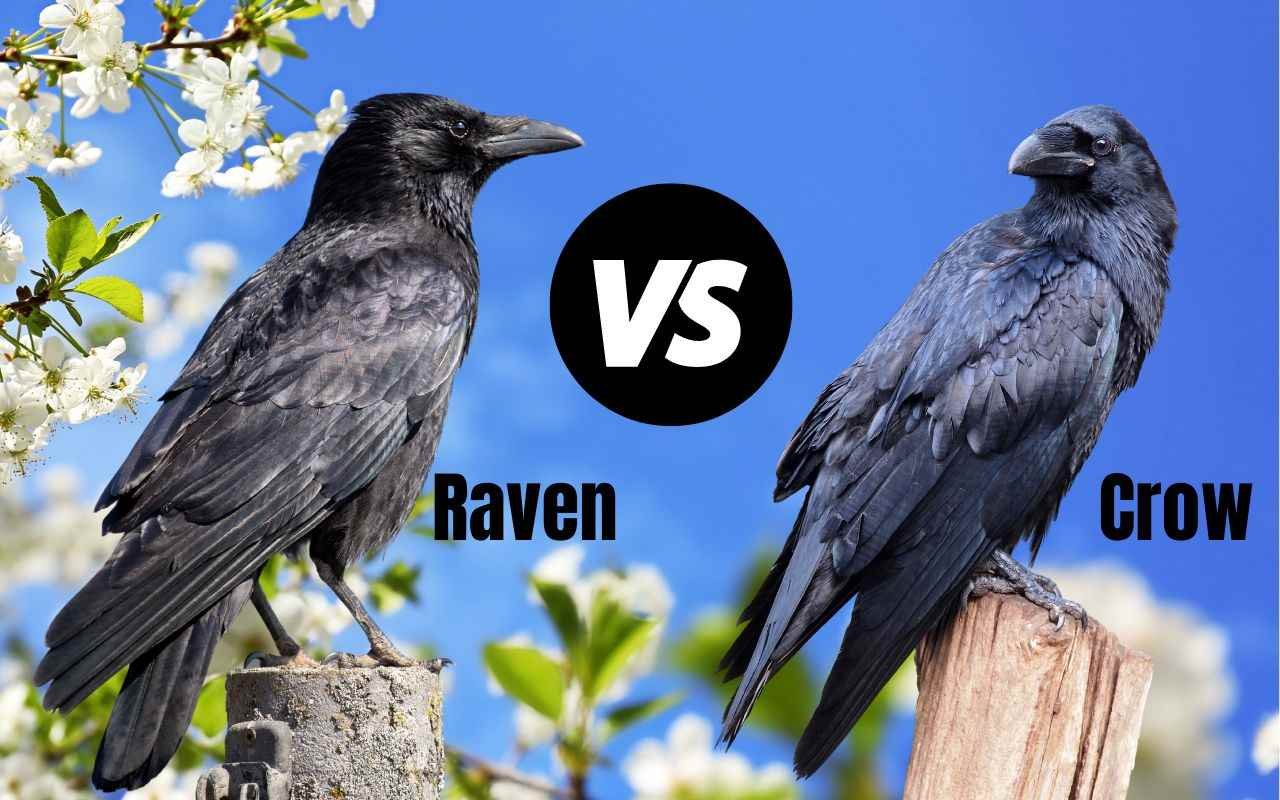Raven Vs Crow - How To Tell Them Apart
Humanized Version
Have you ever found yourself gazing at a large, dark bird perched high on a telephone wire or soaring gracefully across the sky, wondering just what kind of creature it might be? It is a common experience, you know, for many people across North America. These two particular kinds of birds, the common raven and the American crow, happen to share a great deal of the same living spaces throughout the continent, and to the casual observer, they can, in a way, appear quite similar. They both possess that striking dark plumage, that sharp, knowing gaze, and a certain air of mystery about them.
Yet, despite their shared appearance and overlapping territories, there are distinct characteristics that, with a little bit of careful observation and, well, a touch of practice, can help you tell them apart. It truly is a rewarding feeling when you begin to discern the subtle cues that differentiate one from the other. What might seem like a nearly identical bird at first glance actually holds a collection of unique traits, each one a clue in a fascinating puzzle.
This piece aims to walk you through those unique characteristics, those little telltale signs of each bird. Our hope is that by the time you finish reading, you will feel much more confident in identifying whether that impressive black bird you see next is, in fact, a crow or a raven. It is, in some respects, a simple skill to pick up, but it opens up a whole new way of looking at the natural world around us.
Table of Contents
- Spotting the Differences - Raven vs Crow
- What is the primary difference between a raven and a crow?
- How do their voices compare - raven vs crow?
- Does their social life differ - raven vs crow?
- What about their size and shape - raven vs crow?
- Unpacking the Details of Raven vs Crow
Spotting the Differences - Raven vs Crow
What is the primary difference between a raven and a crow?
When you begin to look closely at these two kinds of birds, the common raven and the American crow, you start to notice that while they share a family tree, belonging to the Corvidae group, they carry themselves in rather distinct ways. Both are, of course, large birds with feathers that are a deep, dark shade, and their beaks are just as dark. But, you know, there are several key points that truly help in telling them apart. The differences extend beyond just their looks; they involve their sounds, the way they act, and even, in a way, what they might mean to different groups of people. A raven, for instance, often appears to be a solitary figure, moving through the air with a certain independence. A crow, on the other hand, typically seems to enjoy the company of its own kind, often gathering in larger groups. This contrast in their general demeanor is, you might say, one of the most immediate ways to get a sense of which bird you are observing.
How do their voices compare - raven vs crow?
One of the most striking ways to tell these two birds apart, so it seems, is by listening to the sounds they make. Their calls are, in fact, quite different, and once you hear them side by side, it becomes much easier to distinguish between them. A crow is well-known for its distinctive cry, a sharp, clear sound that many people recognize as a "caw." It's a vocalization that tends to be quite direct, a sort of piercing declaration that carries through the air. A raven, however, produces a sound that is, in a way, completely unlike the crow's. Its vocalization is a deep, resonant sound, more of a throaty utterance, a kind of low croak. This particular sound has a certain richness to it, a depth that the crow's call just does not possess. So, if you hear a very loud, somewhat abrupt "caw," you are probably listening to a crow. If the sound is a much lower, more gravelly croak, then you are, very likely, hearing a raven. This auditory cue is, honestly, one of the most reliable methods for identification.
Does their social life differ - raven vs crow?
Beyond their appearance and the sounds they create, there is also a notable difference in how these birds interact with others of their kind, or, you know, how they generally conduct their daily lives. Crows, it appears, are quite social creatures. They often move about in groups, sometimes quite large gatherings, and you might see them congregating in fields, in parks, or even in urban settings. Their tendency to be around other crows is, in a way, a defining aspect of their existence. Ravens, by contrast, tend to carry themselves with a sense of being somewhat more independent, almost like solitary figures. While you might occasionally see a pair, they are often observed alone, or just with a mate, giving off an impression of quiet self-reliance. This preference for a less crowded existence, a more private way of living, is a key behavioral difference that helps to set the raven apart from its more gregarious cousin. It is, basically, a matter of how they prefer to spend their time.
What about their size and shape - raven vs crow?
When you are trying to figure out if you are looking at a raven or a crow, paying attention to their overall physical dimensions and how they are put together can be very helpful. Ravens, as a rule, are birds that possess a noticeably larger body, a greater physical presence compared to crows. They have a more substantial build, and their wingspan is, well, quite a bit wider. If you see them side by side, or even if you have a good sense of scale, the raven often looks, in some respects, simply bigger. Their tails also tend to be shaped differently; a raven's tail feathers usually form a wedge or a V-shape when it is flying, whereas a crow's tail feathers are typically more fan-shaped or straight across at the end. The way they fly can also give a clue; ravens often soar for longer periods, gliding on air currents, while crows tend to flap their wings more consistently when they are moving through the air. These visual cues, particularly the size and the shape of their tail, are, in fact, quite useful for telling them apart.
Unpacking the Details of Raven vs Crow
Where do these fascinating birds live?
Both the common raven and the American crow are found across a very wide range of places, particularly throughout North America, as I was saying. They are, you know, quite adaptable birds, and you can often find them in various settings. They tend to be common inhabitants around human settlements, such as towns and cities, where they can find food and shelter. You will also see them frequently around agricultural land, which provides ample opportunities for foraging. However, there are, in a way, some subtle preferences in their chosen living environments. While crows are quite at home in more populated areas, ravens often prefer areas that are a little more wild, perhaps open landscapes or forested regions, or even mountainous terrains. The specific kind of place they choose to settle down in, their preferred habitat, is another piece of the puzzle that helps to distinguish one from the other.
Are there other ways to tell a raven vs crow apart?
Beyond the more obvious differences like their size, their calls, and their general behavior, there are a few other subtle indicators that can help you identify whether you are looking at a raven or a crow. For instance, the way their feathers appear can offer a hint. Ravens often have shaggier feathers around their throat, giving them a somewhat "bearded" look, which is not typically seen on crows. Their beaks, while both black, can also differ slightly in their proportions; a raven's beak tends to be a bit more robust and curved compared to a crow's. And then there's the interesting observation about their interactions with other birds. Crows, for example, are known to chase away larger birds of prey, like hawks, from their territories. This particular behavior, this act of defending their space, is something you might witness from a crow. These small details, you know, can add up to a clearer picture when you are trying to make an identification.
What about their intelligence and cultural standing?
Both ravens and crows are, in fact, remarkably intelligent birds, a trait that places them high among the animal kingdom's thinkers. They belong to the Corvidae family, which is widely recognized for its clever members, including jays. Ravens, in particular, have shown an incredible capacity for learning. They can, for instance, even learn to mimic human speech, which is quite a feat for a bird. There are even stories of some ravens being taught to utter specific words, like "nevermore," which is, you know, quite a famous example. This level of intelligence certainly adds to their allure. Beyond their mental capabilities, these birds also hold different meanings in various stories and traditions across different cultures. While both are often seen as symbols, the specific ideas or feelings associated with a raven can be quite distinct from those linked to a crow. These deeper, symbolic differences, while not physical, also contribute to how we perceive each bird.

Raven VS Crow: What's The Difference? - Facts.net

Differences Between Crows and Ravens-What Do You Need to Know About the

Common Raven Vs American Crow